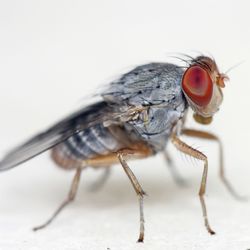Discoveries around innate and adaptive immunity
The immune system can be divided into two parts: the innate and the adaptive systems. The innate immune system exists from birth and acts as barrier against microbes. It is also the first response to an infection; it recognises that there are pathogenic organisms and responds by trying to destroy them and triggering inflammation. If this fails to work, the adaptive immune system creates antibodies and T cells that are specifically designed to target a certain micro-organism.
 Bruce Beutler and Jules Hoffmann were noted for their work on the receptor proteins on cells in the innate immune system that recognise invasive micro-organisms in the body. Jules Hoffmann discovered that fruit flies without the Toll gene were defenceless against bacteria or fungi. This gene was previously only associated with embryonic development and so its role in immunity came as a surprise. In a separate train of research, Bruce Beutler was working on a bacterial product known as lipopolysaccharide (LPS), which can cause septic shock. He found that mice that were resistant to LPS had a mutation in a gene that was strikingly similar to the Toll gene found in the fruit fly. This showed that different animals use similar molecules to activate innate immunity. Since then, a dozen Toll-like receptors have been discovered in humans and mice.
Bruce Beutler and Jules Hoffmann were noted for their work on the receptor proteins on cells in the innate immune system that recognise invasive micro-organisms in the body. Jules Hoffmann discovered that fruit flies without the Toll gene were defenceless against bacteria or fungi. This gene was previously only associated with embryonic development and so its role in immunity came as a surprise. In a separate train of research, Bruce Beutler was working on a bacterial product known as lipopolysaccharide (LPS), which can cause septic shock. He found that mice that were resistant to LPS had a mutation in a gene that was strikingly similar to the Toll gene found in the fruit fly. This showed that different animals use similar molecules to activate innate immunity. Since then, a dozen Toll-like receptors have been discovered in humans and mice.
Research into the innate immune system was very intensive at the time with many researchers contributing evidence and data towards these discoveries. This has led to the Nobel committee facing criticism for their selection of Beutler and Hoffmann, with claims that other researchers contributed as much or even more to our current knowledge and understanding of innate immunity.
Ralph Steinman discovered the dendritic cell, which is responsible for activating the T cells that play a vital role in adaptive immunity. These cells were first extracted from mouse spleen and their activity was demonstrated in cell culture experiments. After four and a half years of battling pancreatic cancer, during which time he used his knowledge of dendritic cells to experiment on himself, Steinman died in 2011 - three days before the Nobel Prize was announced. Since 1974, Nobel winners must be alive at the time of the announcement, however news of Steinman's death did not reach Sweden in time and he was awarded the prize posthumously.
Nobel Prizes were previously awarded in 1908 and 1960 for research into the immune system, including the discovery of phagocytes (cells that consume dead tissue and infectious micro-organisms) and the acquired tolerance of foreign tissue grafts.
Further reading
http://www.nobelprize.org/nobel_prizes/medicine/laureates/2011/popular-medicineprize2011.pdf
http://www.labtimes.org/editorial/e_288.lasso
http://www.nature.com/news/2011/111012/full/478163a.html
Last edited: 27 August 2014 06:02
